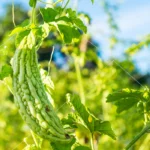How to Incorporate Rice Hulls into Your Farming Practices for Maximum Results
I. Introduction
Rice is a staple food for millions of people worldwide, and rice cultivation generates a significant amount of agricultural waste in the form of rice husks or rice hulls. Rice hulls are the protective outer layer of rice grains that are removed during the milling process. These hulls are an abundant and readily available resource that can be used for various purposes, including agriculture.
In this article, we will discuss the uses of rice hulls in agriculture and farming. We will cover the importance of rice hulls, their advantages and disadvantages, and how they can be used as a soil amendment. Additionally, we will compare rice hulls to perlite, another popular soil amendment. We will also discuss the potential of rice hulls as a renewable resource and their role in sustainable agriculture.
II. Soil Amendments with Rice Hulls
Soil amendments are materials added to soil to improve its physical or chemical properties. Rice hulls are an excellent soil amendment due to their unique properties. They are light, porous, and high in silica, making them an excellent alternative to perlite or vermiculite.
Advantages of Using Rice Hulls as a Soil Amendment
One of the significant advantages of using rice hulls as a soil amendment is their ability to improve soil structure. They are lightweight and do not compact like other materials, allowing for better water infiltration and air circulation in the soil. They also contain high levels of silica, which can help to strengthen plant cell walls, making them more resistant to disease and pests.
Rice hulls also have a high carbon-to-nitrogen ratio, making them an excellent source of organic matter. As they decompose, they release nutrients into the soil, including potassium, phosphorus, and calcium. Additionally, rice hulls are pH neutral, meaning they do not affect the pH of the soil.
Disadvantages of Using Rice Hulls as a Soil Amendment
One of the main disadvantages of using rice hulls as a soil amendment is their slow decomposition rate. Unlike other organic materials, such as compost or manure, rice hulls take a long time to break down. This can be an advantage or disadvantage depending on the situation. In some cases, slow decomposition can be beneficial as it releases nutrients slowly over time. In other cases, quick nutrient release is preferred, making rice hulls less suitable.
Rice hulls can also be challenging to handle due to their lightweight and dusty nature. They can blow away in the wind, making them difficult to spread evenly. Additionally, they can become compacted when wet, making them difficult to incorporate into the soil.
How to Use Rice Hulls as a Soil Amendment
There are several ways to use rice hulls as a soil amendment. They can be incorporated directly into the soil or used as a mulch layer. If using as a mulch layer, it is essential to apply a layer of at least two inches thick to be effective.
When incorporating into the soil, it is recommended to mix the rice hulls with other organic materials, such as compost or manure, to increase nutrient availability and improve soil structure. Additionally, it is essential to keep in mind that rice hulls have a high carbon-to-nitrogen ratio, meaning they can tie up nitrogen in the soil if not mixed with a nitrogen source.
III. Rice Hulls vs. Perlite
Perlite is another popular soil amendment used in agriculture and gardening. Perlite is a volcanic glass that has been heated and expanded to create a lightweight, porous material.
Differences Between Rice Hulls and Perlite
One of the main differences between rice hulls and perlite is their composition. Rice hulls are made from plant material, while perlite is a volcanic glass. Additionally, rice hulls are high in silica, while perlite on the other hand, is composed of small white beads that are formed from volcanic glass that has been heated and expanded. It is lightweight and porous, providing good aeration and drainage for plant roots. However, unlike rice hulls, perlite does not contain any nutrients and has a neutral pH. Perlite is often used as a soil amendment to improve soil structure and prevent compaction. While both rice hulls and perlite can be used as additives to improve soil quality, their different compositions make them suitable for different purposes.
IV. Rice Hulls as a Renewable Resource
Rice hulls are not only a valuable resource for soil amendments, but they are also a renewable resource that can be used in other ways to support sustainable agriculture practices. One of the most common ways rice hulls are utilized is through rice husk combustion.
Overview of Rice Husk Combustion
Rice husk is the outer layer of rice grains that is removed during milling. It is a byproduct of rice production and is often burned as a waste material. However, rice husk can also be used as a fuel source in combustion systems to generate heat and electricity.
In rice husk combustion, the rice husks are burned in a furnace or boiler to produce steam. The steam is then used to drive a turbine and generate electricity. The ash produced from the combustion process can also be used as a fertilizer or soil amendment.
Rice husk combustion is a renewable energy source because it utilizes a waste material that would otherwise be discarded. It also has the potential to reduce greenhouse gas emissions by replacing fossil fuel-based energy sources.
Production of Rice Husk Charcoal
Another way rice hulls can be utilized is through the production of rice husk charcoal. Rice husk charcoal is a form of biochar, which is a type of charcoal produced from organic materials like wood, crop residue, and animal manure.
To produce rice husk charcoal, the rice husks are first carbonized, which involves heating them in the absence of oxygen. This process produces a charcoal-like substance that can be used as a soil amendment.
Benefits of Rice Husk Charcoal in Agriculture and Farming
Rice husk charcoal has several benefits as a planting media. First, it is a lightweight and porous material that can improve soil aeration and drainage. It also has a high water holding capacity, which can help plants retain moisture.
Benefits of Rice Husk Charcoal – In Farming, Agriculture
The utilization of rice husk charcoal as a planting medium offers numerous advantages for plant growth and soil fertility. These benefits include:
Improved Soil Structure:
Burnt husk charcoal possesses high porosity and light weight, which helps maintain a loose soil structure. This allows plants to absorb nutrients effectively, facilitates proper air circulation and nutrient supply, and retains moisture around the plant roots. By incorporating burnt husk charcoal into the planting media, such as pots or polybags, plants can thrive and flourish.
Nutrient Binding in Soil:
The abundant and sizable pores in burnt husk charcoal play a crucial role in binding and absorbing nutrients in the soil. This prevents nutrient leaching when watering, ensuring optimal nutrient availability for plants. Additionally, these pores serve as a favorable habitat for beneficial microbes, promoting a healthy soil ecosystem.
Soil pH Regulation:
Rice husk charcoal possesses a relatively high pH value ranging from 8.5 to 9.0, making it suitable for use in acidic soils to increase the pH level. This adjustment in pH helps create an unfavorable environment for weeds and harmful bacteria. Proper soil pH is essential as it influences the availability of vital nutrients like Nitrogen (N), Potassium (K), and Phosphorus (P), which are crucial for plant growth, development, and defense against pests and diseases.
Enhanced Plant Resilience:
Pests and diseases can significantly impact plant growth and development by hindering nutrient absorption. However, the application of burnt husk charcoal can aid in isolating diseases and absorbing toxins within plants. It can also act as a natural suppressant against certain pathogenic microbes. Moreover, the silica content in burnt husk charcoal strengthens plant leaves, leading to improved structural integrity.
Remediation of Chemically Damaged Soil:
Burnt husk charcoal proves effective in rehabilitating chemically damaged soil. Its incorporation into such soil enhances water absorption, aeration, and drainage capabilities. Consequently, the soil’s water-holding capacity improves, minimizing the risk of rapid soil drying. Furthermore, burnt husk charcoal helps reduce erosion rates and creates a favorable environment for seed germination and plant root development. To further support plant growth, it is advisable to provide appropriate fertilizers based on specific plant requirements and maintain a regular care routine.
The benefits of burnt husk charcoal extend beyond plant health, contributing to the overall improvement of the surrounding environment. These notable advantages make it a valuable and sustainable planting medium. By harnessing the benefits of burnt rice husk charcoal, gardeners and farmers can optimize plant growth and promote sustainable agricultural practices.
V. Rice Hulls for Sustainable Agriculture
Reducing Greenhouse Gas Emissions with Rice Hulls
One of the key benefits of using rice hulls in agriculture is their potential to reduce greenhouse gas emissions. Rice hulls can be used as a biofuel to replace fossil fuel-based energy sources like coal and natural gas.
In addition, the use of rice hulls as a soil amendment can also help to reduce greenhouse gas emissions by improving soil health and fertility. Healthy soils can sequester carbon from the atmosphere and store it in the soil, helping to mitigate climate change.
Using Rice Hulls for Water and Nutrient Management
Rice hulls can also be used to improve water and nutrient management in agricultural systems. When used as a soil amendment, rice hulls can help to increase water infiltration and retention in soil.
Rice hulls also have a high silica content, which can help to improve plant growth and resilience to environmental stressors like drought and pests. Silica can strengthen plant cell walls, making them more resistant to physical damage.
Case Studies of Successful Rice Hull Utilization
There are numerous case studies of successful rice hull utilization in sustainable agriculture practices. For example, in the Philippines, rice hulls are being used as a soil amendment in rice paddies to improve soil health and fertility. This has led to increased rice yields and reduced fertilizer and pesticide use.
Another example comes from Japan, where rice hulls are being used as a medium for growing shiitake mushrooms. The high silica content of rice hulls makes them an excellent substrate for growing mushrooms, and they are also abundant and inexpensive in Japan. This has led to a thriving shiitake mushroom industry in some areas, which provides a sustainable source of income for farmers.
In the United States, rice hulls have been used as a mulch for strawberry production in California. The use of rice hulls as a mulch has been shown to improve soil quality, reduce weed growth, and conserve soil moisture, which results in higher yields and improved fruit quality. Additionally, rice hulls have been used in the production of animal feed as a replacement for traditional ingredients such as corn and soybeans.
Another interesting use of rice hulls is in the production of building materials. In some parts of the world, rice hulls are being mixed with cement to create a lightweight and durable building material that is resistant to fire and pests. This has the potential to provide a sustainable and affordable housing solution for people in developing countries.
VI. Conclusion
The Future of Rice Hulls in Agriculture
As we have seen, rice hulls have many potential uses in sustainable agriculture and beyond. They are a renewable resource that can be used to improve soil health, reduce greenhouse gas emissions, and provide sustainable sources of income for farmers. As such, the future of rice hulls in agriculture looks bright.
However, there are also challenges that must be addressed. One major challenge is the transportation and storage of rice hulls. Since rice hulls are lightweight and bulky, transporting and storing them can be difficult and expensive. This is especially true in areas where rice is not commonly grown, as the cost of transportation can be prohibitive.
Another challenge is the lack of awareness and knowledge among farmers and gardeners about the potential uses of rice hulls. Many farmers and gardeners may not be aware of the benefits of using rice hulls as a soil amendment or mulch, for example. This highlights the importance of education and outreach programs that can help spread the word about the many uses of rice hulls in agriculture.
Recommendations for Farmers and Gardeners
If you are a farmer or gardener interested in using rice hulls in your operation, there are several things you can do to get started. First, consider contacting local rice growers or mills to see if they have any rice hulls available for use. This can be a cost-effective way to obtain rice hulls, as they are often seen as a waste product by rice growers.
When using rice hulls as a soil amendment, it is important to keep in mind that they have a high carbon-to-nitrogen ratio, which means they can tie up nitrogen in the soil if used in large quantities. To avoid this, it is recommended that rice hulls be mixed with nitrogen-rich materials such as manure or compost.
When using rice hulls as a mulch, it is important to apply them in a thick layer to suppress weed growth and retain soil moisture. Rice hulls can be applied directly to the soil, or they can be mixed with other organic materials such as leaves or grass clippings.
The Importance of Sustainable Agriculture
The use of rice hulls in sustainable agriculture practices is just one example of the importance of sustainable agriculture as a whole. Sustainable agriculture practices aim to minimize negative environmental impacts while promoting social and economic benefits. This includes reducing greenhouse gas emissions, conserving natural resources, and promoting the well-being of farmers and communities.
As consumers, we can also play a role in promoting sustainable agriculture practices by choosing to purchase products that are grown using sustainable methods. This can include products that are certified organic, fair trade, or grown using regenerative agriculture practices.
Farmers and gardeners can benefit from incorporating rice hulls into their agricultural practices. By using rice hulls as a soil amendment, they can improve soil health and fertility, increase crop yields, and reduce the environmental impact of their farming practices. In addition, using rice hulls as a renewable resource can reduce waste and promote a circular economy.
As consumers, we also have a role to play in promoting sustainable agriculture practices. By choosing to purchase products that are grown using sustainable methods, we can support farmers who are committed to promoting environmentally friendly practices. This can have a positive impact on the environment, on local communities, and on the quality of the food we consume.
The use of rice hulls in agriculture is a promising area of research and development. As we look towards the future, it is important to continue exploring the potential of this valuable resource, and to promote sustainable agriculture practices that benefit both farmers and the environment.
In conclusion, rice hulls are a valuable resource in sustainable agriculture practices. They can be used as a soil amendment, as a replacement for perlite, as a renewable resource for charcoal production, and even to reduce greenhouse gas emissions. The benefits of using rice hulls in agriculture are numerous, including improving soil health and fertility, reducing the need for synthetic fertilizers and pesticides, and promoting sustainable farming practices.







